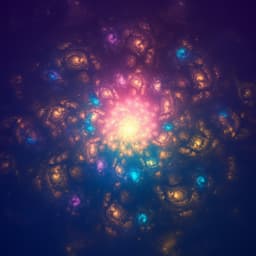
Medicine and Health
Indisulam targets RNA splicing and metabolism to serve as a therapeutic strategy for high-risk neuroblastoma
A. Nijhuis, A. Sikka, et al.
Discover how researchers Anke Nijhuis and colleagues have unleashed the potential of indisulam, a drug targeting RNA splicing factor RBM39, to combat high-risk neuroblastoma. Their groundbreaking study showcases complete tumor regression in xenograft models, reshaping our approach to pediatric cancer treatment.
~3 min • Beginner • English
Introduction
The study addresses the urgent need for effective therapies for high-risk neuroblastoma, a pediatric solid tumor with poor prognosis and frequent MYCN amplification. Indisulam (E7070), an aryl sulfonamide initially developed as a cell-cycle inhibitor with modest clinical responses in prior trials for other solid tumors, was recently shown to act as a molecular glue that promotes DCAF15-mediated ubiquitination and proteasomal degradation of the splicing factor RBM39, leading to aberrant RNA splicing and cell death. Given reports of high DCAF15 expression in neuroblastoma and the reliance of MYCN-driven tumors on precise RNA processing and metabolic programs, the authors hypothesize that indisulam could be particularly effective in neuroblastoma by inducing RBM39 loss with consequent defects in pre-mRNA splicing and metabolism, resulting in tumor growth inhibition and regression.
Literature Review
Prior work established indisulam as a dual sulfonamide with cell-cycle inhibitory activity, affecting G1/G2 checkpoints and cyclins/CDKs via p21/p53 pathways and showing efficacy in xenografts, which prompted Phase I/II testing in various cancers with acceptable toxicity but modest efficacy. Two independent studies elucidated indisulam’s mechanism as a DCAF15-dependent degrader of RBM39 (CAPERα), leading to splicing defects. RBM39 participates in spliceosomal complexes (e.g., U2AF) and acts as a coactivator for transcription factors (AP-1, ER, c-Myc) and may influence metabolism via NF-κB/c-Myc. Public databases indicate neuroblastoma cell lines are among the most sensitive to indisulam, and DCAF15 expression correlates with indisulam sensitivity across many lines. Despite these insights, efficacy had not been tested in neuroblastoma, and the extent to which splicing perturbations translate to proteomic and metabolic alterations required clarification.
Methodology
- In silico sensitivity profiling: Analyzed public drug sensitivity datasets across 758 cancer cell lines (CTD2 network) to identify tumor types sensitive to indisulam and correlated sensitivity with DCAF15 expression.
- In vitro cell models: Neuroblastoma cell lines IMR-32 and KELLY (and additional lines for MYCN analyses) treated with indisulam (typical doses 1–10 µM) for viability (SRB assay), 3D spheroid ATP readouts (CellTiter-Glo), and apoptosis (caspase 3/7 assays). Time- and dose-dependent response profiles were generated.
- Proteomics: Global label-free LC–MS/MS proteomics in IMR-32 after indisulam (5 µM) at 6 h and 16 h to quantify protein abundance changes; validation by Western blot for RBM39, CDK4, TYMS, TRIM27.
- Transcriptomics and splicing: RNA-seq following 5 µM indisulam (e.g., 6 h and 16 h) with alternative splicing analysis (tools referenced: SpliceFisher/SpliceChoice-type pipelines), quantifying exon skipping and intron retention events; targeted RT-PCR assays (e.g., TRIM27 exon 6–7 skipping, CDK4 exon 2–4 skipping; TYMS intron retention) with custom primers.
- DCAF15 dependency: Generated DCAF15 CRISPR–Cas9 knockouts in KELLY; compared responses of DCAF15 WT vs KO to indisulam and E7820 via growth, apoptosis, RBM39 degradation, splicing readouts, and protein levels (CDK4, TYMS, TRIM27). Also assessed correlation of indisulam AUC with DCAF15 mRNA across large panels.
- Metabolomics and flux analysis: LC–MS/MS (HILIC) profiling of intracellular metabolites in KELLY parental, DCAF15 WT, and DCAF15 KO ± indisulam (10 µM, 24 h) with hierarchical clustering. Stable isotope tracing by GC–MS using U-13C-glucose (5.6 mM) to measure labeling into pyruvate, alanine, citrate; and U-13C-glutamine (2 mM) to assess labeling into citrate, aspartate, malate, etc. Data analyzed for fractional enrichment and changes in labeled isotopologues (e.g., M+3 pyruvate, M+2 citrate, M+4 TCA intermediates).
- Bioenergetics and mitochondrial function: Oxygen consumption rate (OCR) measurements after short exposures to indisulam or E7820 in DCAF15 WT and KO; assessment of mitochondrial membrane potential.
- In vivo efficacy and pharmacodynamics: IMR-32 xenograft model in NCG female mice treated intravenously with indisulam (reported 25 mg/kg daily for 8 days) vs vehicle; tumor volume tracking, survival, and relapse monitoring up to 66 days post-treatment. Pharmacodynamic sampling at day 4 for immunofluorescence (RBM39, Ki67), RNA analyses (splicing), proteomics/metabolomics. Th-MYCN transgenic neuroblastoma model treated with indisulam for 7 days vs vehicle, monitored by MRI for tumor volume and long-term survival (>144 days), with assessment of relapse.
- MYCN dependence: Compared dose–response to indisulam and E7820 in MYCN-amplified (BE2C, IMR-32/IMR-35, KELLY) vs non-amplified (SKNAS, SHP-77, SKNSH) lines, and used Tet21 model with doxycycline-regulatable MYCN (MYCN ON vs OFF) for sensitivity differences.
- Statistics: Non-parametric tests (e.g., Mann–Whitney), two-tailed t-tests for densitometry and labeling changes, multiple-testing corrections for splicing analyses; details provided for replicates per experiment.
Key Findings
- Sensitivity: Neuroblastoma cell lines were among the most sensitive to indisulam across 758 lines. In IMR-32 and KELLY, indisulam reduced growth and viability in 2D and 3D spheroids and induced apoptosis (caspase 3/7 increase).
- RBM39 degradation and splicing: LC–MS proteomics showed highly selective RBM39 loss (~96-fold decrease) after 48 h at 5 µM. Extensive RNA mis-splicing observed after indisulam (5 µM, 6 h) in IMR-32: 1,983 significant exon-skipping and 1,517 intron-retention events. Time- and dose-dependent ex vivo assays confirmed mis-splicing (e.g., TRIM27 exon 6–7 skipping). Proteasome inhibitor MG132 rescued RBM39 degradation, confirming proteasome dependence.
- Proteome–transcriptome integration: After 16 h indisulam (5 µM), downregulated proteins substantially overlapped with mis-spliced transcripts (231/367; 62% vs 87/502; 17% among upregulated). Majority of the 231 downregulated–mis-spliced transcripts had intron retention (171/231; 75%). Enrichment implicated cell cycle and metabolic pathways. Cell-cycle proteins CDK4, KIF20A, BUB1 and metabolic enzyme TYMS were decreased and mis-spliced.
- DCAF15 dependency: Indisulam sensitivity correlated with DCAF15 mRNA across large panels; neuroblastoma lines exhibited high DCAF15 expression. In KELLY DCAF15 KO cells, indisulam and E7820 failed to induce growth inhibition, apoptosis, RBM39 degradation, RNA mis-splicing, and reduction of CDK4/TYMS, confirming DCAF15 requirement for on-target RBM39 degradation.
- Metabolic remodeling: Indisulam (10 µM, 24 h) lowered ATP and other nucleotide triphosphates and increased AMP in DCAF15 WT, changes blunted in DCAF15 KO. Increased citrate, isocitrate, serine, and glycine observed; serine/glycine increases replicated in IMR-32. S-adenosyl methionine changes suggested partial DCAF15-independent effects on one-carbon metabolism. U-13C-glucose tracing showed decreased M+3 pyruvate, M+3 alanine, and M+2 citrate in DCAF15 WT, indicating reduced glycolytic flux and glucose oxidation. U-13C-glutamine tracing indicated suppressed glutaminolysis with similar labeling changes in WT and KO, suggesting DCAF15-independent modulation. Indisulam reduced OCR and mitochondrial membrane potential in both DCAF15 WT and KO; E7820 did not reduce OCR, indicating a potential indisulam-specific off-target effect on respiration.
- In vivo efficacy: In IMR-32 xenograft-bearing mice, indisulam induced complete tumor regression with 100% survival and no relapse up to 66 days post-therapy. Day-4 PD analyses confirmed RBM39 reduction in viable tumor (Ki67+ context), mis-splicing, decreased CDK4, and metabolic changes (increased serine and glycine). In Th-MYCN transgenic mice, seven days of indisulam caused near-complete tumor volume reduction; no relapse over >144 days was observed (n=5), with one non-tumor-related death (bowel obstruction).
- MYCN as determinant: MYCN-amplified neuroblastoma lines were more sensitive to indisulam and E7820 than non-amplified lines. In Tet21 cells, MYCN ON cells were much more sensitive than MYCN OFF, suggesting MYCN status predicts response to aryl sulfonamides.
Discussion
The findings support that indisulam’s anti-tumor activity in neuroblastoma is driven primarily by DCAF15-dependent RBM39 degradation leading to widespread mis-splicing, which disproportionately affects cell-cycle and metabolic genes, culminating in growth inhibition and apoptosis. The integration of RNA-seq and proteomics indicates that intron retention events lead to reduced protein levels (likely via nonsense-mediated decay) in key regulators such as CDK4 and TYMS, aligning with the observed cell-cycle arrest-like phenotype and disrupted nucleotide metabolism. Metabolomic and isotope tracing data reveal a broad remodeling of metabolism: decreased nucleotide triphosphates and glycolytic/glucose oxidation flux, accumulation of serine/glycine and citrate, and impaired mitochondrial respiration. Some metabolic and bioenergetic effects persist in DCAF15 KO (e.g., suppression of glutaminolysis and OCR decrease), implying off-target or DCAF15-independent actions of indisulam, in contrast to E7820. In vivo, robust and durable tumor regressions in both xenograft and Th-MYCN models, with corroborating PD biomarkers (RBM39 loss, splicing defects, CDK4 decrease, serine/glycine rise), demonstrate strong translational potential. The greater sensitivity of MYCN-amplified models suggests that oncogenic MYCN increases reliance on proper RNA processing and metabolic programs, rendering tumors particularly vulnerable to RBM39 degradation. Together, these results nominate DCAF15/RBM39 degradation and metabolic reprogramming as a dual mechanism enabling potent anti-neuroblastoma activity and highlight candidate biomarkers (DCAF15 expression, RBM39 loss, specific mis-splicing events, CDK4/TYMS depletion, serine/glycine increases) for clinical translation.
Conclusion
This study demonstrates that indisulam is a potent therapeutic candidate for high-risk neuroblastoma, particularly MYCN-amplified disease. Indisulam induces DCAF15-dependent degradation of RBM39, causing pervasive RNA mis-splicing that downregulates critical cell-cycle and metabolic proteins, and reprograms cellular metabolism, leading to tumor growth inhibition and cell death. In vivo, indisulam achieved complete and durable tumor regressions in xenograft and Th-MYCN models without relapse over extended follow-up, with on-mechanism pharmacodynamic changes confirmed in tumors. The work establishes DCAF15/RBM39 as a vulnerability in neuroblastoma, identifies metabolic consequences of RBM39 loss, and suggests biomarkers to monitor response. Future studies should: (1) validate predictive biomarkers (e.g., DCAF15, MYCN status, specific mis-splicing signatures) and PD markers in clinical samples; (2) delineate and mitigate DCAF15-independent/off-target metabolic effects of indisulam; (3) explore rational combinations (e.g., CDK4/6 inhibitors, nucleotide synthesis pathway inhibitors) and resistance mechanisms; and (4) advance biomarker-driven clinical trials of indisulam or next-generation DCAF15-directed degraders in high-risk neuroblastoma.
Limitations
- Some metabolic and mitochondrial effects (e.g., reduced OCR, glutaminolysis suppression, S-adenosyl methionine changes) were not rescued in DCAF15 knockout cells, indicating potential off-target or DCAF15-independent actions of indisulam that require mechanistic clarification.
- TYMS protein detection exhibited complex antibody-epitope dependency, potentially confounding interpretation of its regulation.
- In vivo studies, while compelling, involved modest cohort sizes and preclinical models; clinical efficacy and safety in neuroblastoma patients remain to be established.
- Splicing analyses rely on specific computational pipelines and timepoints; broader time-course and cross-platform validation could refine the catalog of functionally consequential mis-splicing events.
- The study primarily focuses on two neuroblastoma lines for deep mechanistic work; broader validation across diverse genetic backgrounds would strengthen generalizability.
Related Publications
Explore these studies to deepen your understanding of the subject.







